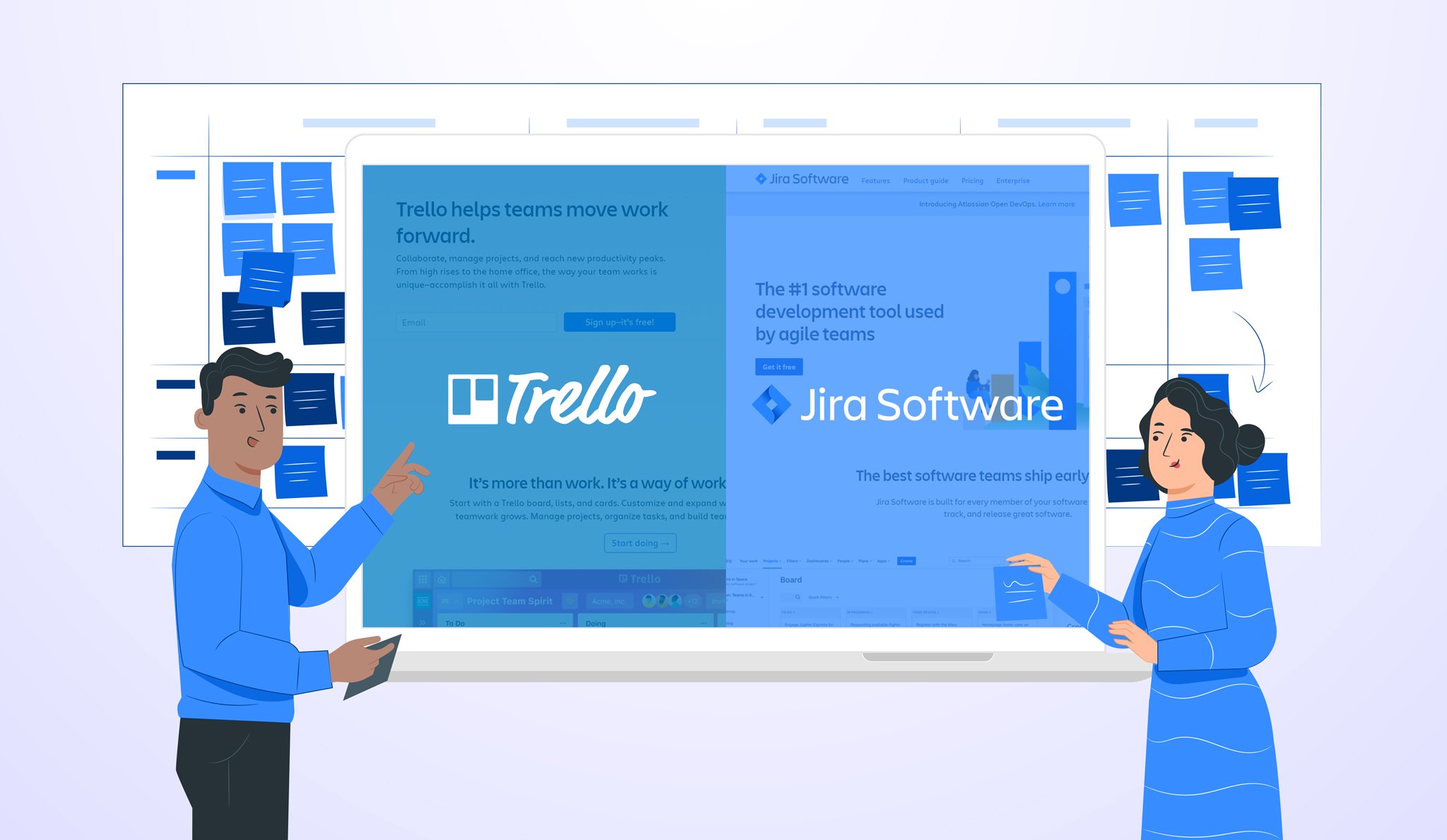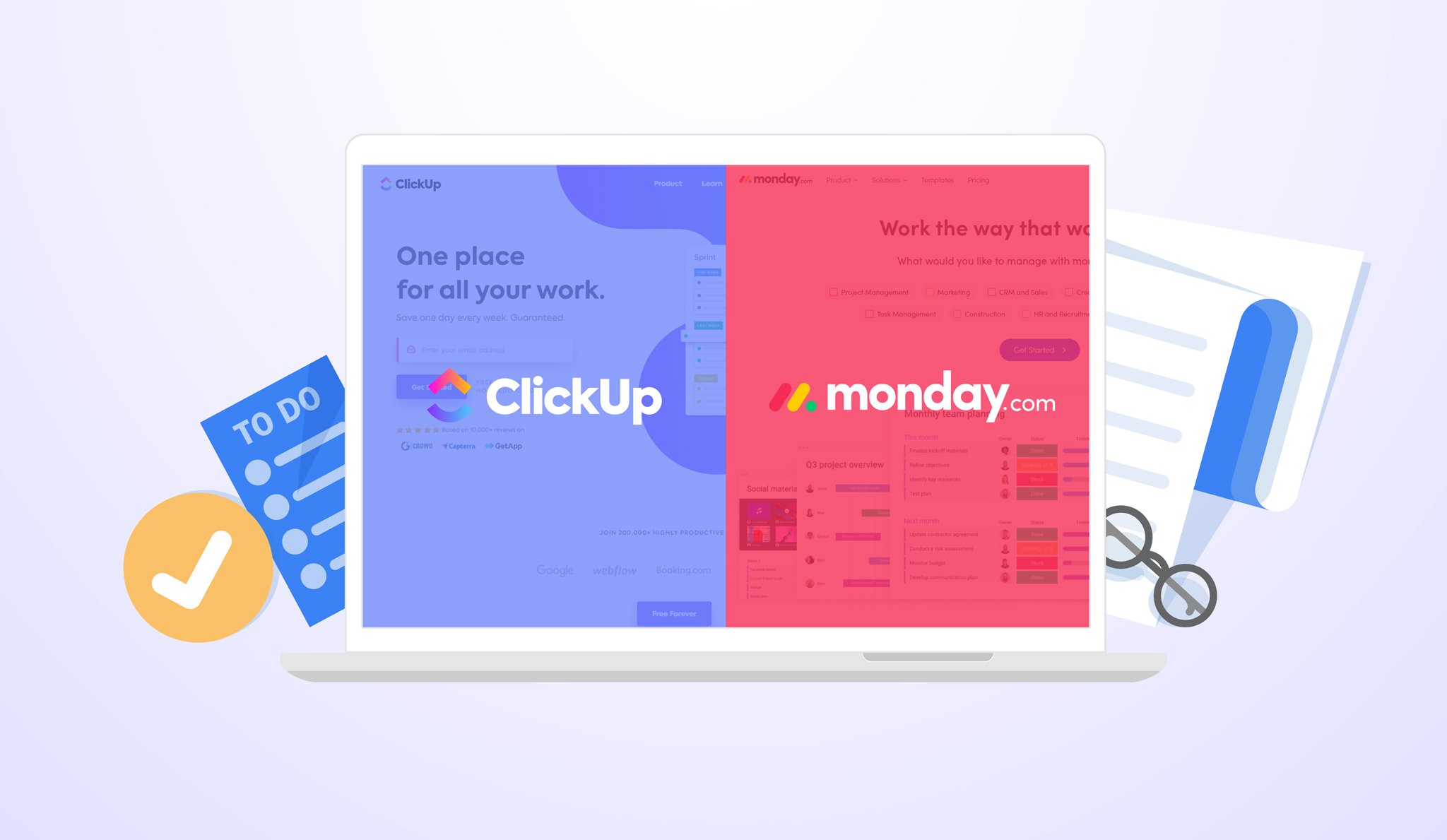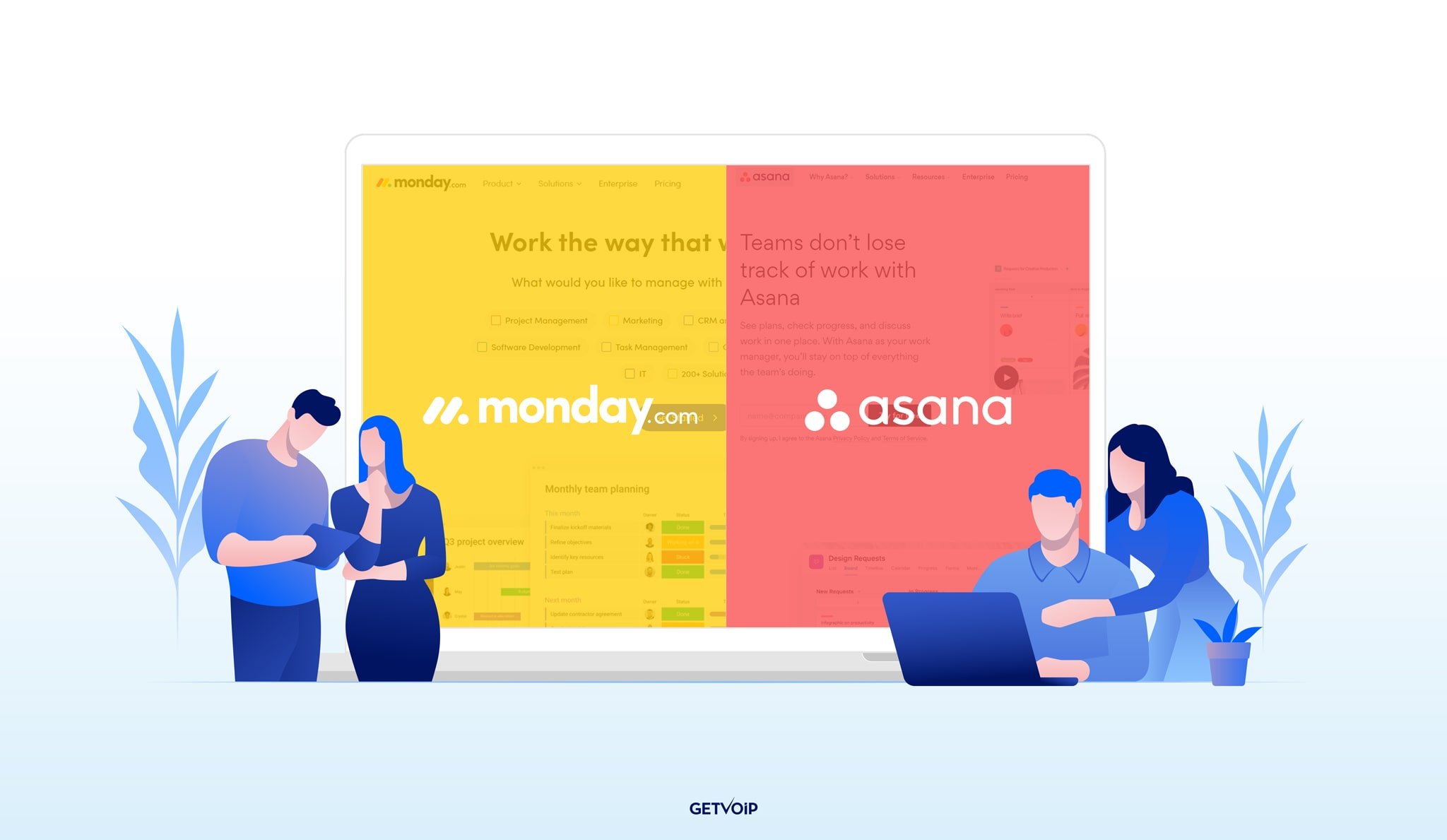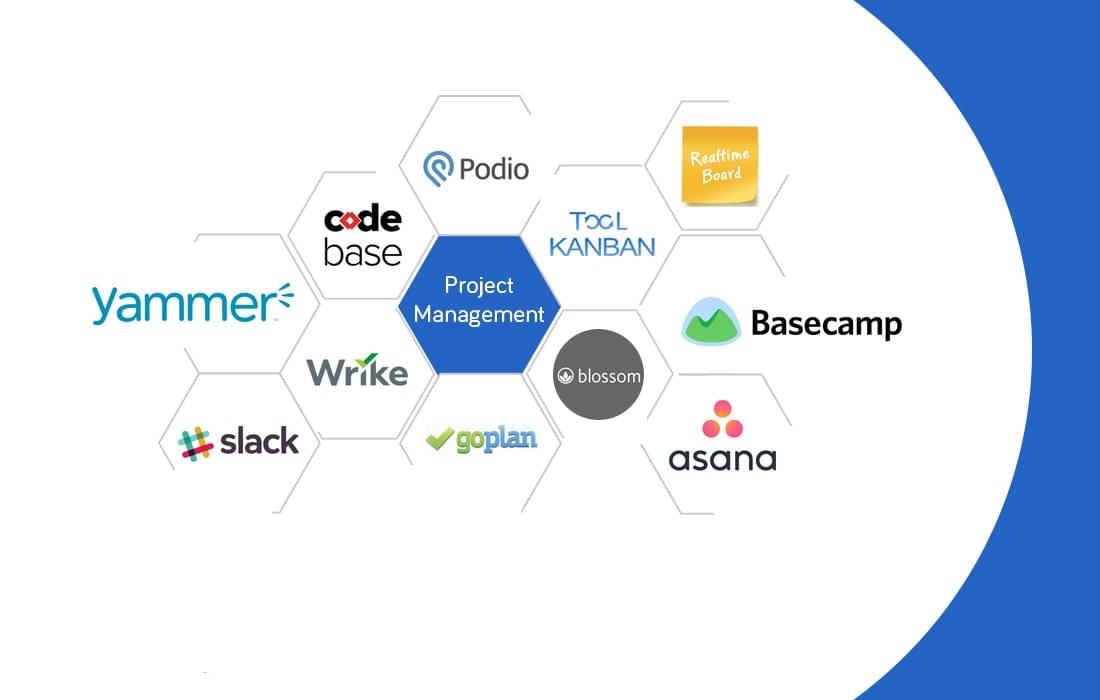Project management tools are often a necessity for teams looking to manage all of their ongoing projects. But these tools are not one-size-fits-all. Trello and Jira are two of the most prominent tools on the market, but they are completely different from one another — we'll help you decide if one of these tools is right for you.
In this article, we will cover the following sections. We'll discuss everything from prominent Trello and Jira features to pricing. By the end of this article, you'll be able to judge which project management tool is right for you.
- Trello vs Jira Overview
- Jira vs Trello Features
- Agile Project Management
- Third-Party Integrations
- Pricing
- Trello and Jira Frequently Asked Questions
Trello vs. Jira Overview
Trello is a collaboration tool that enables teams to have a shared perspective on any project. The tool offers boards, lists, and cards so users can prioritize anything they need in a flexible and fun way. Its cards and boards are designed to be a better way for teams to work together in a way that is unique to them.
Jira is an issue tracking and project management software used by 180,000 customers in 190 countries. It is made by Confluence and it is geared toward software development teams that need to plan, track, and release great software. You can connect your team's work to the overall product roadmap so you can ship faster and more reliably.
Here’s a quick overview of each tool. In the table below, you’ll see a brief introduction to the features, integrations, and starting price to expect for both Trello and Jira.
| Trello | Jira | |
| Top Features | Cards Power-ups Butler automation Keyboard shortcuts | Scrum boards Agile reporting Automations Enhanced security |
| Top Integrations | Google suite Slack Adobe | Microsoft Zoom Google suite |
| Starting Price | Trello offers a free plan. The cheapest paid plan is $10/user/month, billed annually. | Jira offers a free version of their app. The cheapest paid plan is $7/user/month, billed annually. |
Trello vs. Jira Features
Here's a quick look at the features you can expect from each project management tool.
Trello
Cards
Every Trello board has cards attached to them, which are how users keep track of tasks. Since these cards are so vital to Trello, they come with their own set of thorough features.
- Card Descriptions — Here, users can add specific information about tasks relating to each card, such as directions or website links.
- Comments and Activity — Comments can be added to cards so you can easily collaborate and communicate with team members.
- Card Back — Flip around the cards to see their descriptions, comments and activity. Users can also add members, checklists, and due dates to tasks.
- Labels — Teams can add labels to cards to better organize them by properties such as teams or subjects. These labels are completely customizable and can be color-coded in order to best keep your projects organized.
- Card Repeater — This feature allows users to automate the creation of cards for tasks that repeat themselves over any given timeframe
- Checklist — Every Trello card can come with a checklist so users can continue to break down projects into as many details as needed to best collaborate with team members.
Power-Ups
Trello is known for its power-ups, as they easily enhance a team's productivity. Here are some power-ups Trello users can leverage.
- Calendars — With a calendar integration, you'll be able to see your due dates in a calendar view
- Google Drive — By integrating Google Drive, users can have quick access to file attachments from the back of their card. You can also do this with Box and Dropbox integrations as well.
- Custom fields — Custom fields ensure you can access structured information like costs, phone numbers, and more directly on Trello cards. This will be visible on both the front and the back of the card.
Butler Automation —Butler allows users to set up automations, rules, and commands within Trello boards so users can cut down on repetitive work. You don't need advanced coding skills to implement these automations, meaning that it's easy for anyone to implement it. Simply click on the Butler icon in your Trello board menu, and begin giving it automations to create. These automations include rules, buttons, due dates, and calendars.
Jira
Scrum boards — Jira's scrum framework enables agile teams to manage their projects by creating a culture of collaboration that promotes iterative, incremental delivery. These boards are a single source of truth for all the work a team needs to complete.
Since any team member can access these boards, everyone can understand what is expected of them, which helps to quickly identify potential blockers. With access to this information, project managers can expect easy sprint planning and iterative development.
Kanban boards — Kanban boards give your team full visibility into what’s next, allowing you to continuously deliver maximum output in minimal cycle time. Kanban boards let teams know where work stands at a glance by displaying the most relevant information for each story, issue, bug, or task.
They depict work at various stages, which optimizes your team's workflow. With this power, you can prevent bottlenecks so that issues flow smoothly through your workflow.
Roadmaps — Jira's roadmaps allow teams to plan smarter, communicate better, and release more predictably. They offer advanced roadmaps in Jira Premium, which ladders work from multiple teams or projects up to a feature or goal with unlimited levels of hierarchy above the epic level. Basic roadmaps that allow you to plan and track progress for a single team are available in all Jira software plans.
Automation — Jira automations allow teams to save time and deliver value faster. These automations can be up and running in a matter of seconds, as no coding or scripting is necessary. The project management tool enables any task or process to be automated with just a few clicks.
You can boost your team's productivity with these automations, as they do manual work to keep Jira up to date. That way, you and your team can focus on what matters. Jira allows users to automate at scale, so teams of every size can work smarter than before.
Agile Project Management
Agile project management refers to the iterative approach to delivering a project throughout its life cycle. These life cycles are composed of several steps towards the completion of a project, meaning that project managers oversee individual steps to completing the goal as opposed to the overall project tracking.
While Jira is specifically known as an agile project management software, Trello can serve that need for teams as well. In fact, Hubstaff Blog states that Trello can even be your secret weapon for agile work.
Splitting large projects into smaller chunks is at the core of the agile methodology. The scrum framework, which exists within the agile methodology, refers to meetings, tools, and roles that work together to help teams structure and manage their work.
Trello serves both of these frameworks by the way that it is visually designed. The project management tool is a digital whiteboard. So instead of needing to place sticky notes on columns on physical whiteboards, Trello offers boards, lists, and cards.
You can easily rename and reorder any lists to align the current needs of the project you’re working on. Cards can be moved from list to list with no problem. They also contain all the information a project manager needs to know what is happening in each task. That makes it a great tool for agile project planning.
Jira, on the other hand, is known for being an agile project management solution. Jira even offers specific tutorials on how to use the tool for agile methods. You can leverage the software to drive a scrum project, prioritize and organize your backlog into sprints, run scrum ceremonies and more.
Teams can leverage this functionality in order to create sprints in order to nail down the time frame necessary to finish certain tasks. Once a sprint cadence is determined, the team perpetually operates on that cadence.
Jira's project boards are also geared specifically toward the agile process. These boards display issues from one or more projects in columns that represent the team's process. Once your team has created a Jira board, it provides the team with a shared view of all work that hasn't started, work that is in progress, and work that is completed.
You can break those boards down into scrum boards, which manage stories, tasks, and, and bugs in sprints. Users can also create Kanban boards, which are used to manage stories, tasks, and bug tracking in a continuous flow.
Integrations
Here's a look at each tool's top integrations.
Trello
Trello is known for its power-ups, which include third-party integrations. These plugins turn Trello into a completely customizable tool that fits your specific needs. You can toggle to the menu on the right side of the screen and enable the integration of your choice. That will allow you to bring the tool right into your Trello board.
While some integrations are automatically included as power-ups, it's important to note that the two terms are not interchangeable. Some Trello power-ups simply just allow users to bring additional features to their boards.
Trello offers more than 100 integrations for its users. But it's important to note that not all of these integrations are offered out-of-the-box with Trello. You may need to use Zapier as the way you connect your third-party platform to Trello. Some of Trello's top integrations include Slack, Adobe, Jira, Salesforce, Mailchimp and more.
Jira
Jira offers more than 3,000 integrations, apps, and add-ons so teams can spend less time managing work and more time building great products. Each integration can be custom-tailored to fit any and every business's unique use case.
As the Jira website writes, on average, software developers check 3.3 tools simply to discover the status of a project, while Jira Software customers rely on fewer tools (2.3 tools), saving valuable time, and increasing productivity.
Jira offers integrations broken out by teams who might use the tools the most. Design teams can leverage AdobeXD, Draw.io, and Lucidchart. IT teams can use the GitHub, Slack, and Zendesk integrations, along with various CRM apps. Large and small business teams can leverage Trello, Microsoft Teams, and Goole Sheets. Software engineering teams can leverage CircleCI, Launch Darkly, and Jenkins.
Pricing
Here’s a breakdown of each tool’s pricing plans.
Trello
| Free | Business Class | Enterprise | |
| Price | Completely free of charge | $10/user/month, billed annually | Contact sales for a quote |
| Overview | For individuals and teams looking to be more productive. | For teams that need to track multiple projects and visualize work in a variety of ways. Best for teams up to 100. | For companies that need to connect work across teams and enhance org-wide controls, security, and support. Ideal for organizations of 100+. |
| Top Features | Unlimited cards Unlimited members Up to 10 boards 1 Power-up per board | Everything in the previous plan Unlimited boards Unlimited Power-ups Dashboard view | Everything in the previous plans Organization-wide permissions Organization-visible boards Public board management |
Jira
| Free | Standard | Premium | Enterprise | |
| Price | Completely free of charge | $7/per user | $14/per user | Billed annually. Reach out directly for a quote. |
| Overview | For small teams to plan and track work more efficiently | For growing teams focused on building more together | For organizations that need to scale how they collaborate and track work | For enterprises with global scale, security, and governance needs |
| Top Features | 10 users Scrum and Kanban boards Backlog Agile reporting Customizable workflows | Everything from the previous plan Domain verification and account capture Project roles Advanced permissions Audit logs | Everything from the previous plans Capacity planning Project archiving IP allow listing 99.9% guaranteed uptime | Everything from the previous plans Atlassian access 24/7 enterprise support Data residency 99.95% guaranteed uptime |
The Final Verdict
Both Trello and Jira can be used for agile project management. But as Jira was specifically designed as an agile-based solution, it edges out Trello. Jira allows its users to create sprints and scrums, which is perfect for running agile-based projects. This project management tool ensures that users can successfully work on projects in the cadence that will allow them to create the best final project. Depending on the number of users and the complexity of your products, one of the two tools will perform better for you.
Trello is better for smaller teams and freelancers looking for a quick way to manage their projects and ensure that they don’t miss anything. On the other hand, Jira works much better for larger, agile teams of developers that need a great system for managing their development workflows.
Frequently asked questions
You can see where your board currently resides by clicking next to its name. Once you do click on it, you can move it to any other existing board.
When you create a board, select "Private" as the visibility option. The tool also gives you the flexibility to decide who has access to your content and who does not.
Workflow is defined as a movement of the bug/issue through various stages during its life-cycle. You can use the app to create custom workflows for your needs.
You can either email issues through the share option in Jira or tag other users in a comment field.



